
|

|

|

|
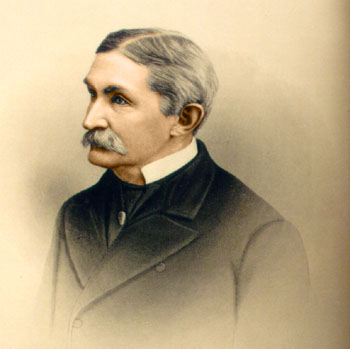

|
Henry Livingston Lansing (15 Jan 1818, Rome NY - 30 Sep 1889, Canandaigua NY) (son Barent Bleecker Lansing and Sarah Breese) (brother Henry Seymour Lansing) + (28 Feb 1820, NYC - 25 Oct 1897, Canandaigua NY) Catharine Gibson (21 Nov 1683, Albany NY - 25 Oct 1897, Canandaigua NY) (dau Henry B. Gibson and Sarah Sherman
CHILDREN:
Captain Livingston Lansing (23 May 1841, Canandaigua NY - Aft. 7 Dec 1910)
Charles Miller Lansing (27 Jun 1843 - 14 Jul 1884)
Sarah Lansing (17 Aug 1846, Utica NY - 11 Feb 1877, Buffalo NY)
Watts Sherman Lansing (b:17 Sept 1850) |
| History of Ontario County | ||||||||||||||||||||||||||||||||||||||||||||
|
Henry Livingston Lansing,
was born
in Rome, N. Y., in the year 1818. He was educated for a business
career, and on leaving school engaged in the mercantile business at
Utica. In 1836 he accepted an offer of a clerkship in the Ontario Bank
at Canandaigua, N. Y., an institution in which his paternal and maternal
grandfathers were large stockholders, and in the year 1838 married
Catherine Olivia, daughter of Henry B. Gibson, cashier and manager
of that bank.
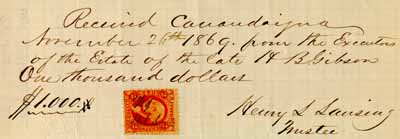 Mr. Lansing remained in the bank with his father-in-law for a number of years, and then went with his family to Detroit, Mich., where he accepted the cashiership of the bank called "The Michigan Insurance." Remaining only a year or so in this bank Mr. Lansing was called to the cashiership of the Oliver Lee & Company Bank, Buffalo, N. Y., which institution he remained in as cashier, and afterwards as president, until the bank was forced, in the great panic of 1857, to shut its doors. Some time after the failure of the bank, Mr. Lansing accepted the office of treasurer and secretary of the Buffalo and Erie Railroad, with its office at Buffalo. This position he held for a number of years, filling the office with great acceptability to the directors of the company. Resigning his office, Mr. Lansing, about the year 1873, purchased a charming country place at Niagara, Ontario, and there he passed his summers until the time of his death in 1889. A member of New York's Military Association, he rose to the rank of Brigadier General of the 31st New York Militia during the Civil War. Mr. Lansing was essentially. a domestic man, he was fond of his home and devoted to his family. He was ever led to seek the highest happiness in his own domestic circle and possessed in a high degree those social qualities which belong to the refined and cultured gentleman. In a certain sense Mr. Lansing was the fruit of hereditary culture his father and grandfather on the paternal and materna1 side were bon vivants and connoisseurs. He prided himself upon his accurate judgment and discrimination in the choice of and selection of fine wines, and was an epicure in the best sense of the word, a lover of life's good things. In one particular, in which business men are too generally negligent, Mr. Lansing excelled; he had cultivated the art of letter writing until his epistolary style became of rare excellence. He could express himself in the readiest and neatest way with great apparent ease, his letters were bubbling over in sentiment, expressed with great felicity and beauty, as all who ever received them will bear testimony. Mr. Lansing was extremely fond of the sylvan sports, was an exceedingly good shot and an expert fisherman. In the years gone by, in order to indulge in the latter sport, he was compelled to make his own flies, and it was that accomplished gentleman and skillful sportsman, Alexander Jeffrey of Lexington, Ky., but who at that time lived in Canadaigua, who taught him how to make and use them, and it was this same gentleman who taught Seth Green, of Rochester, N.Y., who became the State's most expert fisherman, all he knew about angling. [On the 3rd of July, 1839, Alexander Jeffery married Delia, the daughter of Maj. Gen. John Albert Granger. Delia's sister Julia married Sanders Irving, the nephew of Washington Irving. Alexander Jeffery's second wife was Rosa Vertner, a Kentucky poet descended from a Declaration Signer, who gave a series of lectures on Robert Browning during their sojourn in D.C.] Mr. Lansing was a most delightful companion and enjoyed good company, but it had to be the best in order to afford him any pleasure. He was extremely fond of poetry and had no end of quotations upon his tongue's end, and possessed the unusual faculty of being able to repeat from memory whole pieces, no matter how long they were, provided they awakened a responsive chord. Mr. Lansing, coming as he did from a military family, very naturally inherited military tastes, and shortly after the outbreak of the Civil war was appointed by the governor of New York chairman of the Senatorial Committee of his Senatorial District, which was composed of the following very prominent citizens of Buffalo: Nathan K. Hall, Stephen G. Austin, Jacob Beyer, John Ganson, Philip Dorsheimer, and Alexander W. Harvey. At this time Mr. Lansing was brigadier-general of one of the brigades attached to the Eighth Division of the State militia. Mr. Lansing served faithfully upon this committee and through its efforts Colonel Chapin's regiment, the One Hundred and Sixteenth New York Volunteers, and McMahon's Irish regiment, the Corcoran Guards, were organized, recruited, and sent to the front, where they did most excellent service. Mr. Lansing departed this life, after a tedious illness which he bore with great fortitude, at Canandaigua, on the morning of the 30th of September, 1889, and left him surviving a widow and two sons, Livingston and Watts Sherman Lansing. He was buried at Forest Lawn Cemetery, Buffalo, N.Y.
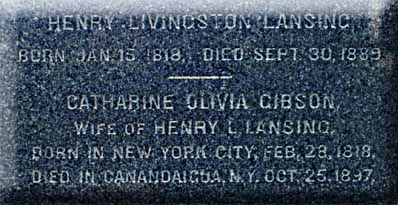 | ||||||||||||||||||||||||||||||||||||||||||||
| Military Association of New York | ||||||||||||||||||||||||||||||||||||||||||||
|
Henry Livingston Lansing, like his brother Henry Seymour Lansing, was active in the formation of
The Military Association of New York.
The Chair appointed on such Committee:-- | ||||||||||||||||||||||||||||||||||||||||||||
| Civil War | ||||||||||||||||||||||||||||||||||||||||||||
|
Henry Livingston Lansing was named
to an 8 person senatorial State committee with the responsibility
of putting together NY state regiments for the Civil War.
He was made a Brigadier General, and commanded the 31st NY Militia in Buffalo,
supplying men for the Draft Riots of New York City.
JUNE 3-AUGUST 1, 1863.--The Gettysburg Campaign No. 417.--Report of Col. David S. Forbes, Sixty-eighth Regiment New York State National Guard, of operations June 25-July 31.
NELSON RANDALL On the 17th of June, 1863, I received the following Special Orders from Brig. Gen. Henry L. Lansing, commanding Thirty-first Brigade, Buffalo, Erie County:
SPECIAL ORDERS, No. 296 Maj. Gen. Nelson Randall, Eighth Division, National Guard of the State of New York, will detail from his command the Sixty-fifth, Seventy-fourth, Sixty-seventh, and Sixty-eighth Regiments, to take the field immediately for three months' Service. He will dispatch them by regiments, via Elmira, to Harrisburg, Pa,, and report to Major-General Couch, commanding. Arms and camp equipage will be supplied in Harrisburg. General Randall will make the necessary requisitions upon Capt. Sheldon Sturgeon, U.S. Army, mustering and disbursing officer at Buffalo, for transportation direct to Harrisburg, and call upon him for the necessary subsistence.
By order of the Commander-in-Chief Accompanying the above was the following:
SPECIAL ORDERS, No. 3
In pursuance of the above Special Orders, No. 296, dated June 16, 1863, from the Commander-in-Chief, Col. D. S. Forbes, Sixty-eighth Regiment, will order his regiment to prepare for immediate service.
By order of Maj. Gen. Nelson Randall: RUFUS L. HOWARD, Division Inspector In pursuance of the above Special Orders, I immediately promulgated the following Special Orders:
SPECIAL REGIMENTAL ORDERS, No. 2 In pursuance of Special Orders, No. 296, and Special Orders, No. 3, headquarters Eighth Division, Maj. Gen. Nelson Randall commanding, the officers, non-commissioners officers, musicians, and privates will forthwith report at these headquarters, Fredonia, for duty, for the purpose of proceeding to Harrisburg, Pa. Commandants of companies will immediately promulgate this order to their respective commands, and report to me forthwith the number of effective men in their companies, with muster-rolls made complete. Non-commissioned staff and musicians will report to Adjt. Francis L. Norton. Commissioned officers will appear uniformed and equipped, all others in citizens' dress, as uniforms and equipments will be furnished in Harrisburg. Commandants will enlist for three months all able-bodied men who desire to enter the service, thereby increasing the number of the regiment. Each soldier should be provided with two shirts, two pairs of drawers, two pairs of socks, one towel, comb, soap, and knapsack or satchel, which, with its contents, should be as light as possible. The citizens of Chautauqua County are requested to use every effort to add to the ranks of the Sixty-eighth Regiment under this order, thereby, as is believed, lessening the number of men liable which are to be raised under the conscription act. By order of D. S. Forbes, colonel commanding Sixty-eighth Regiment New York State National Guard: FRANCIS L. NORTON, Adjutant. ************************ July 2.--I received from the Buffalo Board of Trade $500, and from General Henry L. Lansing $100, generously donated and placed in my hands to be disbursed for the benefit of the brigade; but for this timely donation my command would have suffered greatly in its subsequent marches, Government not providing at all times adequate transportation and subsistence. *************************
WASHINGTON, D.C.
General WOOL SIR: Adjutant-General Sprague, now here, informs me that Colonel [Henry L.] Lansing, at New Dorp, has 300 or 400 men available for the riot, and also two companies, under Major [George W.] Scott, on Riker's Island. General Sprague says these are all subject to your orders. The marines and sailors at the navy-yard and receiving ship will, I presume, co-operate, if applied to by you.
JAMES B. FRY, **********************************
ADJUTANT-GENERAL'S OFFICE That by further evidence this day filed in this office said county has furnished subsequent to said 7th of February, 1863, up to the 10th of August, 1863, 1,058 three-years volunteers, which, added to the above-mentioned surplus of 78, gives a total of 1,136 furnished over and above the quota under the two calls of July I and August 4, 1862, for which total of 1,136 the county of Erie stands credited on the records of this office. All the above-mentioned evidence is certified to by Henry L. Lansing, chairman of the military commitee of the Thirty-first Senatorial District, appointed by circular from this office dated July 5, 1862, and which evidence is now on file in this department.
JOHN T. SPRAGUE | ||||||||||||||||||||||||||||||||||||||||||||
| Canandaigua Home | ||||||||||||||||||||||||||||||||||||||||||||
|
Henry Livingston Lansing worked in the Ontario Bank, under the Cashiership of Henry B. Gibson, one of the richest
men in western New York. On the 28th of February 1820, Henry Lansing married Gibson's daughter Catharine. The house which they built close
to Catharine's parents' home was on Gibson Street, and is now an historical landmark.
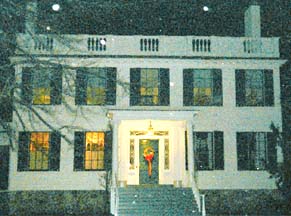
CITY OF CANANDAIGUA: | ||||||||||||||||||||||||||||||||||||||||||||
| Buffalo Home | ||||||||||||||||||||||||||||||||||||||||||||
|
The first time Henry L. Lansing appears in a Buffalo directory is in 1848, when he is shown
as cashier of the Michigan Insurance Bank. There is no address given. But the following year, 1849,
Henry has moved to a position as cashier of the Oliver Lee & Company Bank, and his address
shows as being the corner of Delaware and Johnson Place. In 1852 Henry becomes president of the Oliver
Lee bank, and continues as president until the bank collapses in the great panic of 1857. For the
next few years, he gives his business address as his home address.
Then, in 1860, Henry shows up as the Treasurer of the Buffalo and Erie Railroad, and his address is now 106 Delaware. The family stays in that house until 1868, the year after their daughter Sarah marries General Henry L. Burnett, one of the special Judge Advocates at the Lincoln assassination trial, when they move a block to 274 Delaware. From 1868 to 1876, the family stays in their third house, though Henry retires fron his position as Secretary and/or Treasurer of the Railroad in 1870. For several years they overlap the home in Buffalo with their new summer house in Niagara-on-the-Lake, but in 1876 they move out of Buffalo in a massive move. From the 25th of October to the 4th of November, they pay James Craise and Samuel Courtney to move 30,010 lbs of furniture, etc. Though Henry and Catharine's address changes often over the 25 years they lived in Buffalo, they never had to move. It was the city that did the changing. The home that they bought was located at the corner of Delaware and Johnson Place. And when they finally DID move out of it, they moved 30,000 lbs of furniture and life accumulations. 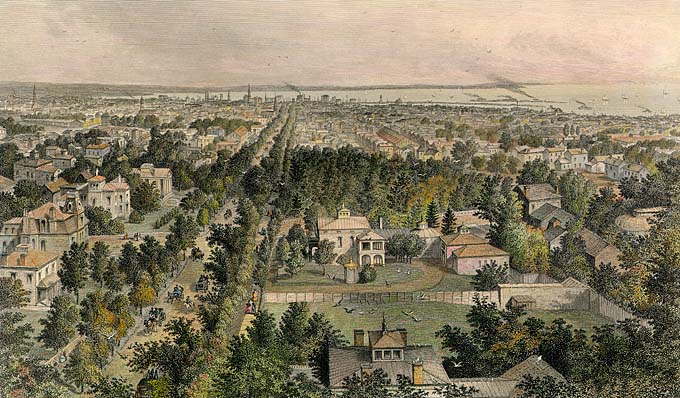 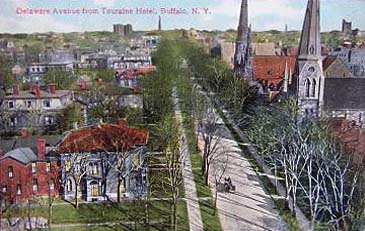 The view from the Tourlaine Hotel, built on the site of their home Delaware Avenue was a good address. The houses around them were large, and filled with families with whom they had much in common - emigrees like them from Western New York. Relatively close to the center of Buffalo, they were surrounded with other bankers, lawyers and railroad men. To one side of their house was the Johnson "Cottage" (cottage, as in Newport Cottage), later the Female Seminary. Strange considering the proximity of the school, granddaughter Catharine was sent to the Utica Seminary. On the other side was the home of John Ganson. Like Henry, Ganson was president of a bank and he, too, was hard hit by the panic of 1857. Ganson eventually sold his home and left Buffalo, but Henry stayed on. Both his father-in-law, Henry B. Gibson, and Henry's first cousin, Watts Sherman, had invested heavily in Henry's bank, so the pain from the collapse of the Oliver Lee was felt throughout the family. Gibson tested the new bankruptcy laws all the way up to the NY Appeals Court from the NY Supreme Court but, in the end, the stockholders carried the responsibility for the debt incurred by the bank. Given the size of the houses, it wasn't surprising that Ganson's brother-in-law, John Sibley lived with the Gansons in the north end of the house. John Sibley's father was the jurist and politician Mark Hopkins Sibley. His wife was Catharine Gibson Lansing's sister, Mary Young Gibson, named for Henry B. Gibson's brother-in-law, Colonel Samuel Young, the speaker of the New York Assembly and a failed candidate for governor. At the end of the block past the Cottage was the residence of Archbishop Arthur Cleveland Coxe, whose daughter Grace married Catharine and Henry's son Livingston, and moved in with the Lansings. Also nearby were the Seymour and Jewett families, names later aligned with the Lansings by marriage. 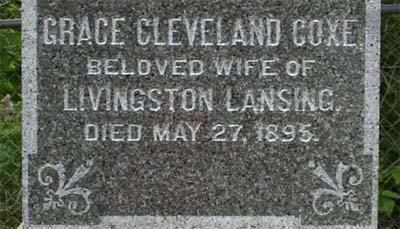
| ||||||||||||||||||||||||||||||||||||||||||||
| ||||||||||||||||||||||||||||||||||||||||||||
| Niagara-on-the-Lake Summer Home - Woodlawn (now called Randwood) | ||||||||||||||||||||||||||||||||||||||||||||
|
The property that Henry bought for $18,000 as a summer house sat opposite the Army parade grounds. Henry
called it Woodlawn, though the name was changed by a later owner to the one by which it's known
today, Randwood.
Catharine's mother lived in Canandaigua, in the bank building that became their home after they retired the Ontario Bank. Upon Sarah's death in 1881, they were back to living in two homes - the Gibson home in Canandaigua, and Woodlawn in Niagara-on-the-Lake. Then, when Henry died in 1889, the Niagara house passed to his son Watts, then passed to Watt's brother Livingston's daughter, Katherine Cleveland Lansing McDonald (23 July 1878-?). Both Henry and his wife Catharine died in their Canandaigua home.
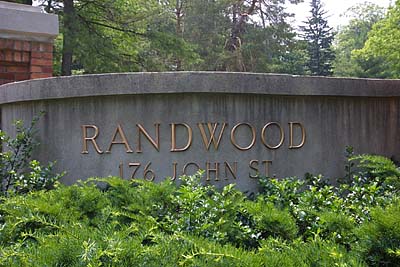 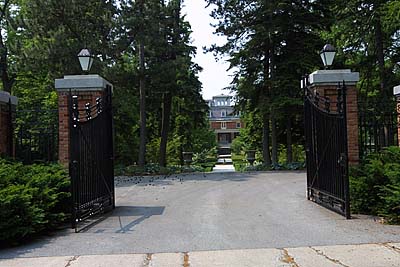 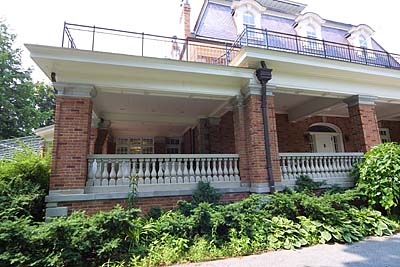 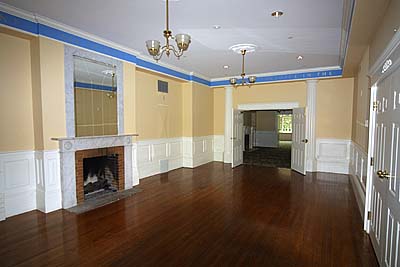 | ||||||||||||||||||||||||||||||||||||||||||||
| Back to Canandaigua | ||||||||||||||||||||||||||||||||||||||||||||
|
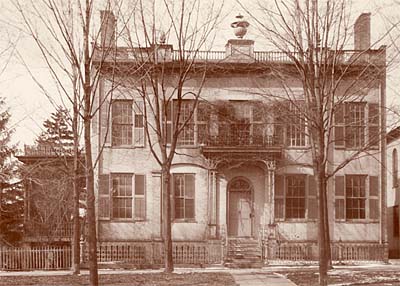 After the death in 1881 of Catharine Gibson Lansing's mother, Henry and his wife Catharine inherited the large Gibson house in Canandaigua, which had previously been the Ontario Bank building. After Henry's death in 1889, Catharine sold Randwood and continued living in the Gibson home. On Catharine Lansing's death in 1898, the house was willed to the neighboring church, just visible on the right of the picture. The house was torn down to allow expansion of the church.
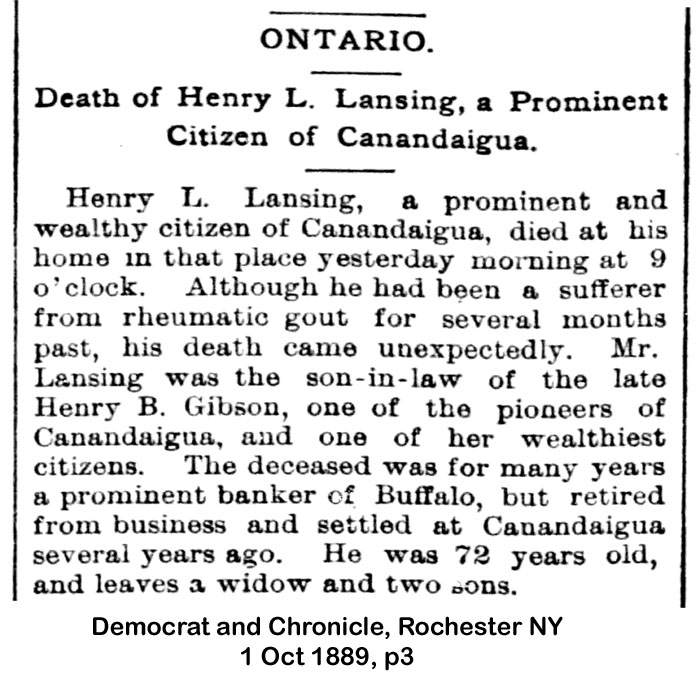
 | ||||||||||||||||||||||||||||||||||||||||||||
| Will | ||||||||||||||||||||||||||||||||||||||||||||
|
I, Henry L. Lansing of the township of Niagara, County of Lincoln Canada, but at this present writing residing in the Village of Canandaigua, County of Ontario, State of New York, United States of America, do make and declare this to be my last will and testament.
First: I give and bequeath to my wife Catharine Olivia, all the furniture, paintings, engravings belonging to me, also my library and all my horses, harnesses and carriages all of which are now in "Woodlawn" Canada. Second: I give and bequeath to my sister Manette, wife of C.W. Morse of Saybrook, Connecticut, two thousand dollars, par value, of the stock of the Erie & Pittsburgh Rail Road Co (that is, forty shares at fifty dollars per share.) Third: I give and bequeath to my grandson and namesake Lansing Burnett, son of my deceased daughter Sarah, my gold watch chain and locket, two pairs of gold sleeve buttons and two gold scarf pins. Fourth: I give and bequeath to my grandson and namesake Harry Livingston Lansing, son of my son Livingston, my double-barreled breechloading shotgun and all the traps belonging thereto with gun xx, also all my fishing rods and tackle and artificial flies and bait. Fifth: I give and bequeath to Ellen Gillen who has been a faithful servant in my family for many years, Five hundred dollars par value | ||||||||||||||||||||||||||||||||||||||||||||
| The Schooner H. L. Lansing | ||||||||||||||||||||||||||||||||||||||||||||
|
H. L. LANSING Other names : none Official no. : none Type at loss : schooner, wood, 3-mast [also recorded as a bark] Build info : 1852, Bidwell & Banta, Buffalo Specs : 362 t. om Date of loss : 1865, Oct 27 Place of loss : near Chicago Lake : Michigan Type of loss : storm Loss of life : (none) Cargo : coal Detail : She was stranded and destroyed in a gale. Owned by Whitaker & Co., Detroit. Stranded in a storm near New Buffalo, MI, in early December, 1856. The tug SALVOR out of Chicago got a pump on her, but gave up due to weather. Rescued the following spring. Aground and heavily damaged on Colchester Reef in November of 1864. Major repairs in 1853. Sources: nsp,hgl,rsl |


1860 Census, Erie, Buffalo Ward 10

1870 Census, Erie, Buffalo Ward 10








|
NJ Governor Lewis Morris |
 Breese Family |
 Night Before Xmas Henry Livingston |
 President George Bush |
 Father Bradley Van Deusen |
 Mother Jean Van Deusen |
 Home |
 Suggested Favorite Pages |
 Site Map |
 Copyright © 2004, Mary S. Van Deusen
Copyright © 2004, Mary S. Van Deusen
|